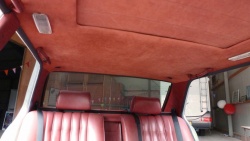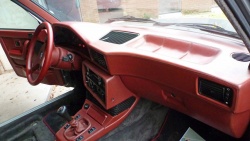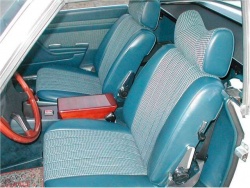Difference between revisions of "Full leather trim"
| Line 27: | Line 27: | ||
==[[Split leather]] in cars== | ==[[Split leather]] in cars== | ||
| − | + | The vehicle manufacturers also increasingly use [[Coated leather - Laminated leather|coated]] or [[split leather|embossed split leather]] for the unloaded areas (door linings, headrests), but also for [[Leather steering wheel|steering wheels]] and the shift knobs without corresponding declaration. The buyer acquires in good faith a [[leather quality|high-quality]] "leather interior" or "full leather trim" and receives low quality [[split leather]] on areas outside the contact area. Since these are [[Coated leather - Laminated leather||coated and embossed]], even [[Leather expert - Leather consultant|specialists]] can not recognize whether it is a more valuable [[Top grain leather|grain leather]] or a cheaper [[split leather]]. Therefore the purchaser should consciously ask and leat assure in the purchase contract that no split leather is bought. | |
| − | + | In the case of leather furniture, the regulation can be different from country to country. In Germany it is regulated that [[split leather]] should not be used in the contact area, but it must nevertheless be pointed out clearly that it has been used. In this case, the consumer is informed of what he has purchased. Strange, that this only for furniture. One must assume that the strong lobby of the car industry in Germany has prevented this regulation for [[car leather|vehicle leather]] and sells cars all around the world where the consumer is not adequately informed about the value of the used materials. | |
| Line 37: | Line 37: | ||
</p> | </p> | ||
<p align=center> | <p align=center> | ||
| − | ''[[ | + | ''[[Car leather#BMW|BMW]] E28 M5 of 1986 with full leather trim. Even the area under the roof is made of [[nubuck]], which is not expected even with a full leather trim.''<br></p> |
<p> </p> | <p> </p> | ||
| Line 45: | Line 45: | ||
</p> | </p> | ||
<p align=center> | <p align=center> | ||
| − | '' | + | ''Classic partial leather interior. - partial leather interior the [[car leather#Opel|Opel]] Omega.''<br></p> |
<p> </p> | <p> </p> | ||
| Line 52: | Line 52: | ||
</p> | </p> | ||
<p align=center> | <p align=center> | ||
| − | ''[[ | + | ''[[Car leather#BMW|BMW]] Z1 "fun yellow" with partial leather interior.''<br></p> |
<p> </p> | <p> </p> | ||
| Line 60: | Line 60: | ||
</p> | </p> | ||
<p align=center> | <p align=center> | ||
| − | + | ''Lancia with [[alcantara]]-leather-combination. - [[car leather#BMW|BMW]] X3 with partial leather interior.''<br></p> | |
<p> </p> | <p> </p> | ||
| Line 68: | Line 68: | ||
</p> | </p> | ||
<p align=center> | <p align=center> | ||
| − | '' | + | ''No partial leather interior: [[car leather#Mercedes|Mercedes]] Fabric-[[Man made leather|artificial leather]]-combination and Volkswagen Golf "Aigner" (ot enough leather to call it "partial leather interior").''<br></p> |
<p> </p> | <p> </p> | ||
| Line 76: | Line 76: | ||
</p> | </p> | ||
<p align=center> | <p align=center> | ||
| − | ''[[ | + | ''[[Car leather#BMW|BMW]] partial leather interior. Black leather outside, inside fabric woven with [[leather strips]].''<br></p> |
<p> </p> | <p> </p> | ||
Revision as of 07:17, 19 February 2017
Contents
Full leather trim - Leather appointed - Leather trim
Car manufacturers sometimes sell the interior of a vehicle as a "full leather interior" or "leather appointed" or "leather trim" with corresponding surcharge. In such cases it is assumed, that the entire interior with a grained smooth surface is covered with genuine leather and no artificial leather or plastic parts are processed.
In some countries, the terms "leather trim", "full leather trim" and "partial leather trim" are defined.
According to this, 80% of the expected surfaces of a "leather trim" should be covered with genuine leather.
For a "full leather trim", all surefaces are expected to be real leather. These include the seats (except the back side of the seats), the dashboard, the panels, the center console and also the steering wheel (outer rim only) and the shift knob.
Partial leather trim
The seats in vehicles are not always completely made of leather. Sometimes only the contact surfaces are made of genuine leather, but the side panels, the backs of the backrests and headrests or the armrests are made of imitation leather. Such seats do not have a "leather trim". The only exceptions are the backs of the seats to be a "leather trim".
Partial leather trims are car seats, where some contact areas are made of leather, and the rest is alcantara, artificial leather or fabric. However, it is only "partial leather" if minimum the middle lanes or the outer flanks are made of genuine leather.
Split leather in cars
The vehicle manufacturers also increasingly use coated or embossed split leather for the unloaded areas (door linings, headrests), but also for steering wheels and the shift knobs without corresponding declaration. The buyer acquires in good faith a high-quality "leather interior" or "full leather trim" and receives low quality split leather on areas outside the contact area. Since these are |coated and embossed, even specialists can not recognize whether it is a more valuable grain leather or a cheaper split leather. Therefore the purchaser should consciously ask and leat assure in the purchase contract that no split leather is bought.
In the case of leather furniture, the regulation can be different from country to country. In Germany it is regulated that split leather should not be used in the contact area, but it must nevertheless be pointed out clearly that it has been used. In this case, the consumer is informed of what he has purchased. Strange, that this only for furniture. One must assume that the strong lobby of the car industry in Germany has prevented this regulation for vehicle leather and sells cars all around the world where the consumer is not adequately informed about the value of the used materials.
BMW E28 M5 of 1986 with full leather trim. Even the area under the roof is made of nubuck, which is not expected even with a full leather trim.
Classic partial leather interior. - partial leather interior the Opel Omega.
BMW Z1 "fun yellow" with partial leather interior.
Lancia with alcantara-leather-combination. - BMW X3 with partial leather interior.
No partial leather interior: Mercedes Fabric-artificial leather-combination and Volkswagen Golf "Aigner" (ot enough leather to call it "partial leather interior").
BMW partial leather interior. Black leather outside, inside fabric woven with leather strips.
Additional information




















 a kotori web solution
a kotori web solution